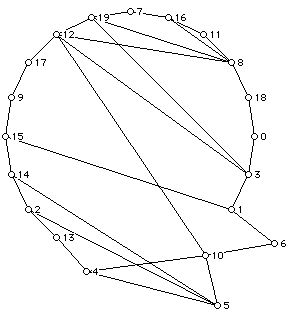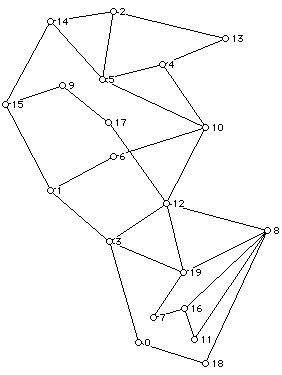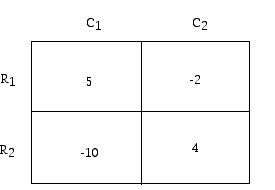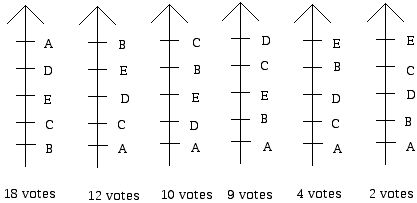
Figure 1
Mathematical Modeling in the Behavioral Sciences: Sampler
Prepared by:
Joseph Malkevitch
Department of Mathematics and Computer Studies
York College (CUNY)
Jamaica, New York
email:
malkevitch@york.cuny.edu
web page:
http://york.cuny.edu/~malk
When most people think of where mathematics can be applied they think of physics, engineering, and chemistry. However, since World War II the applicability of mathematics in the behavioral sciences and social sciences has become increasingly widespread. Here is a sampler of problems, some stated without contexts and others within contextual settings, which show a small portion of the range of tools and contexts for mathematics in the behavioral sciences.
Network Science
The diagrams below (Figures 1 and 2) consisting of dots and line segments are known as graphs. Think of the graph as representing 20 people and displaying "connections" between the people. The dots of a graph are known as vertices and the line segments are called edges.
Question 1
In Figure 1, graph G:
a. How "far" is vertex 3 from vertex 8?
b. How "far" is vertex 2 from vertex 8?
c. What is the "farthest" any vertex can be from vertex 8?
d. What is the "farthest" any pair of distinct vertices can be in this graph?
e. What is the "closest" any pair of distinct vertices can be in this graph?

Question 2
In Figure 2, graph H:
a. How "far" is vertex 3 from vertex 8?
b. How "far" is vertex 2 from vertex 8?
c. What is the "farthest" any vertex can be from vertex 8?
d. What is the "farthest" any pair of distinct vertices can be in this graph?
e. What is the "closest" any pair of distinct vertices can be in this graph?

Question 3
Figures 1 and 2 certainly look different but in some sense are they the "same?"
Question 4
When graphs are used as models, the vertices are chosen to represent something (e.g. people or houses) and two vertices are joined by an edge when some property holds for the objects that the vertices represent. For example, the vertices may represent people, and two people could be joined by an edge if they are from cities in the same state of the US. Could the graphs above arise in this way? Invent some contexts in which the graphs in Figures 1 and 2 might have been produced.
Games I
Players named Row and Column independently choose a row (choice of two) and column (choice of two), respectively. The "payoff" is shown in the cell at the intersection of the chosen row/column pair. For example if Row plays Row 2 and Column plays Column I, Row loses 21 and Column wins 3.
Column I Column II
Row 1 (-4,-4) (3, -21)
Row 2 (-21, 3) (2, 2)
i. How should Row and Column play this game to achieve his/her best result if the game is played:
a. Once?
b. Many times?
ii. Can you think of "real world situations" where this game would be a suitable model?
Games II
Players named Row and Column independently choose a row (choice of two) and column (choice of two), respectively. The "payoff" is shown in the cell at the intersection of the chosen row/column pair. The payoffs shown are from Row's point of view. Column's payoff is the negative of the number shown. For example if Row plays R1 and Column plays C2, then Column wins 2 units and Row loses the amount Column wins, 2 units.

i. Is this a fair game?
ii. How should Row and Column play the game to achieve his/her best result if the game is played:
a. Once?
b. Many times?
Two-sided Markets
8 hospitals (left) and 8 medical students (right) have ranked each other as indicated in the tables below. For example Hospital 5 has ranked Medical Student 2 second, while Medical Student 4 has ranked Hospital 2 fourth.

i. What is a reasonable way to pair off the hospitals and medical students?
ii. Can you give other "real world" situations that have a similar "flavor" to this problem?
Comment: Alvin Roth and Lloyd Shapley won the 2012 Nobel Memorial Prize in Economics for the ideas (also pioneered by David Gale) which are actually used to match hospitals and residents in the United States.
Elections
The ballots below show the rankings of 55 faculty for 5 choices of textbooks. Which book deserves to be selected as the choice for the group?

(Note: There is no indifference; higher preferences towards the top.)
Bankruptcy
There are three merchants who have verified claims against the remaining assets of a small bankrupt company. What would be a fair way to settle the claims in each case?
Example 1:
Claimant A B C (Assets Remaining: $200)
Claim $30 $100 $100
Example 2:
Claimant A B C (Assets Remaining: $200)
Claim $30 $200 $300
Apportionment
The four divisions of a college, Arts, Sciences, Business, and Teacher Education have enrollments of:
2,180
1,880
1,420
640
A wealthy alumna of the college has decided to donate 30 scholarships to attract new students based on the different divisions' enrollment.
a. What is a fair way to assign the 30 scholarships to each division?
b. What would be a fair assignment if there were 31 scholarships?
Fair Division
Bob (B) and Alvin (A) are siblings and have each, without the input of the other, assigned a dollar value to several items that their mother Nancy has willed to them. Each of the brothers has enough cash to make payments to the other in order to equalize any possible division that is suggested.
A B
Turkish Rug $1100 $1800
Stamp Collection $1900 $1200
Book Collection $20000 $30000
Ethnic Jewelry $6000 $5000
What would be a fair way to handle the situation? (What would you do if the brothers had listed the same amount for some items?)
Cost Sharing I
Towns A and B with populations of 12 and 8 (in hundreds of thousands) need to build a new sewage treatment plant.
Stand alone costs (in millions of dollars):
{A} = 160 {B} = 90
Joint cost: {A, B} = 200
How should A and B proceed?
Cost Sharing II
Towns A, B, and C with populations of 12, 10, and 8 (in hundreds of thousands) need to build a new sewage treatment plant.
Example 1:
Stand alone costs (in millions of dollars):
{A} = 150 {B} = 120 {C} = 90
Joint costs:
{A, B} = 240 {A, C} = 220 {B, C} = 180
{A, B, C} = 325
How should A, B, and C proceed?
Example 2:
Stand alone costs (in millions of dollars):
{A} = 150 {B} = 120 {C} = 90
Joint costs:
{A, B} = 240 {A, C} = 220 {B, C} = 180
{A, B, C} = 315
How should A, B, and C proceed?
Legislative Fairness
The five towns in Rural County have populations of 7, 4, 3, 3, and 1 (in hundreds of thousands), respectively.
Is it fair for the representatives of these 5 towns to cast 7, 4, 3, 3, and 1 vote, respectively, where 10 votes are required to take action in the county legislature?
Based on your analysis of the situation above how would you approach structuring the legislature of a political union such as the European Union which has an established voting scheme after a new member is added. For example, if Ukraine or Turkey were added to the European Union what approach to governing the new "union" should be taken?
Transplants
Which of these factors should be taken into account in deciding whether or not someone is a suitable candidate for a transplant?
How famous the patient is?
How wealthy the patient is?
How old the patient is?
How sick the patient is?
How long the patient has been waiting for a transplant?
Measuring Inequality
i. What is the difference between wealth and income?
ii. How might one measure the extent to which there is income or wealth inequality in two different countries?
iii. Should markets set the pay that a worker receives or should there be regulations which require " equal pay for equal work?"
References
Aumann, R. and S. Hart (Eds.) Handbook of Game Theory with Economic Applications, North-Holland, New York, Volume 1, (1992), Volume 2, (1994).
Balinski, M. and H.P. Young, Fair Representation, Yale University Press, New Haven, 1982.
Brams, S. and A. Taylor, Fair Division, Cambridge U. Press, New York, 1996.
COMAP, For All Practical Purposes, 9th Edition, W.H. Freeman, NY, 2013.
Kemeny, John G., and James Laurie Snell. Mathematical models in the social sciences. Vol. 9. New York: Ginn, 1962.
Kuhn, H. (ed.), Classics in Game Theory, Princeton U. Press, Princeton, 1997.
Mc Lean, I. and A. Urken, Classics of Social Choice, U. Michigan Press, Ann Arbor, 1995.
Moulin, H., Axioms of Cooperative Decision Making, Cambridge U. Press, New York, 1988.
Robinson, J. and W. Webb, Cake-Cutting Algorithms, A K Peters, Natick, 1998.
Roberts, Fred S. Discrete mathematical models, with applications to social, biological, and environmental problems Prentice-Hall, Englewood Cliffs, NJ, 1976.
Saari, D., Geometry of Voting, Springer-Verlag, New York, 1994.
Straffin, P., Game Theory and Strategy, Mathematical Association of America, Washington, 1993.
Taylor, A., Mathematics and Politics, Springer-Verlag, New York, 1995.
Young, H.P. (Ed.), Fair Allocation, American Mathematical Society, Providence, 1985.
Young, H.P., Equity, Princeton U. Press, Princeton, 1994.